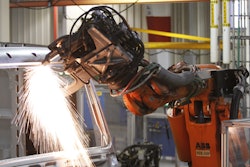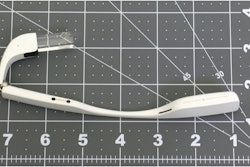SANDUSKY, Ohio (AP) — Imagine an acoustic chamber cranking out sound waves so powerful they would liquefy your organs if you somehow were inside that room as it was being operated at full blast.
Or a 122-foot-high vacuum chamber that can only be sealed into place by moving concrete doors that are 50 feet tall and 50 feet wide, each weighing an incredible 5.5 million pounds.
A visit to NASA Glenn Research Center's satellite campus, the sprawling 6,400-acre Plum Brook Station in Erie County, is a science nerd's paradise.
It offers amazing sights never seen by millions of Ohioans and tourists from around the world who converge on nearby attractions including Cedar Point amusement park.
That will change a little next year, as NASA marks the 75th anniversaries of its Glenn Research Center, which is based in Cleveland, and its Plum Brook Station, which is just south of Sandusky.
The space agency's 2016 events will include two sets of open houses, both giving the public a chance to tour facilities and meet astronauts: May 21-22 at NASA Glenn and June 11-12 at Plum Brook.
They will be the first tours for the general public since 2008.
Plum Brook doesn't allow walk-in visitors but hosts about 1,000 area school-age groups a year.
"We don't care if they're science geeks or not," said Dave Stringer, Plum Brook Station director.
NASA Glenn is one of the space agency's 10 field centers around the country.
Plum Brook is part of it.
Both began in 1941 to help America prepare for World War II.
Along with other NASA centers, both also had roles in research and development of Apollo's lunar landing module in the 1960s.
More recently, Plum Brook had a research function for the Mars Pathfinder and the Mars Exploration rovers' airbag systems.
Known as the Aircraft Engine Research Laboratory, NASA Glenn's original focus was on building aircraft engines for the war effort.
In 1941, the U.S. Army Corps of Engineers acquired 8,700 acres of land south of Sandusky, mostly from farmers, to bolster the war effort.
By that November — just before Japan's Dec. 7, 1941, attack on Pearl Harbor — the land was used to make TNT.
Later, Plum Brook, which became a national historic landmark in 1986, was carved out of that land in 1958 at a cost of $25 million.
Now, 74 years later, more than 200 scientists, public officials, and journalists met in late November inside Plum Brook's Space Power Facility — one of four remaining buildings on that campus — for an event hailed as a milestone for what is expected to be a new era in manned space travel to Mars and beyond.
That ceremony marked the arrival of the European Space Agency's service module for Orion, a 75-foot spacecraft NASA has under development with help from European scientists.
Most of the rocket's frame is being built at NASA's Michoud Assembly Facility near New Orleans, with interior work scheduled to be added later at the Kennedy Space Center in Florida.
Plum Brook's connection is in testing the crucial European Space Agency service module that is being designed to provide astronauts their propulsion, electricity, air, and water once they reach outer space.
Once a nearly identical replica is put through a series of rigorous vibration, acoustic, strength, and temperature tests, the real hardware — with any tweaks that need to be made — will undergo the same.
U.S. Rep. Marcy Kaptur, a Democrat from Toledo, told the audience it was "witnessing history and building the future."
But like the space program itself, Plum Brook has had its ups and downs.
The site has had as many as 10,000 workers and as few as 12 over the years.
"Plum Brook is an intriguing place that inspires an air of mystery," historian Mark D. Bowles of Cuyahoga Falls wrote in the preface of his book, Science in Flux: NASA's Nuclear Program at Plum Brook Station 1955 - 2005, published by NASA in 2006.
One Plum Brook director, according to Bowles' book, told a newspaper reporter in 1998 that many people believed NASA was doing "something secret" like "housing a flying saucer" inside the station.
Stringer, who became the site director in 2007, said the station closed in 1974, largely because of costs America had incurred from its involvement in the Vietnam War.
It remained closed for the next 12 years but was reopened in 1986 to test solar arrays for Freedom, a proposal for a space station that former President Ronald Reagan supported in his 1984 State of Union address.
Freedom was never built. Plans for it eventually were rolled into the International Space Station program.
Plum Brook survived an effort to close it again in 1995.
Although NASA has spent $130 million in recent years to expand its testing capability, two-thirds of the site's facilities have been demolished since 2006, Stringer said.
The demolition work has included the decommissioning of NASA's second and final Plum Brook nuclear reactor in 2012. The land where it stood for decades is now clear and, in 2013, the Nuclear Regulatory Commission signed off on the work.
The changes are a sign of NASA's evolving mission, Stringer said.
"It's not like we're trying to hug everything and wait around to see if it'll be used," he said.
Stringer said NASA is making an additional commitment to Plum Brook's future by upgrading the station's sign and front gate at a cost of $6 million to meet government security standards in response to the terrorist attacks of Sept. 11, 2001.
The station was chosen to test the European Space Agency service module because it has the world's only vacuum chamber large enough to test rockets and components in a nearly pressure-free environment.
It is 122 feet high by 100 feet wide.
The vacuum chamber was built in 1969 of pure aluminum.
Rick Sorge, Plum Brook's space power facility test manager, said NASA used that metal because of its interest in nuclear-powered research in the '60s.
Aluminum doesn't absorb gamma rays, he explained.
The chamber has the aluminum equivalent of a billion soda pop cans, Sorge said.
Sealing its 5.5-million-pound doors shut is an automated, 30-minute process, Stringer said.
Another one of the most eye-catching features at Plum Brook is the reverberant acoustic test facility, an acoustic chamber with woofers and loudspeakers so incredibly large that fans of heavy metal music would drool.
Humans can't be inside it while operating. Long before their organs would liquefy, their eardrums would burst.
Capable of cranking out 163 decibels, it is the most powerful acoustic chamber in the world, Stringer said.
Its purpose is to simulate the sound at liftoff, roughly as loud as the thrust of 20 jet engines.
The only bigger one is a Lockheed Martin acoustic chamber in Denver. But it does not produce as many decibels, he said.
Extreme temperatures and vibration are easy-to-understand stresses upon liftoff or travel in outer space.
But sound?
"Anything that goes close to the speed of sound has shock waves," Stringer said.






















